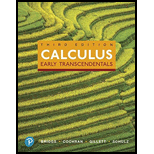
Concept explainers
World population (part 2) The relative growth rate r of a function f measures the rate of change of the function compared to its value at a particular point. It is computed as r(t) = f′(t)/f(t).
a. Confirm that the relative growth rate in 1999 (t = 0) for the logistic model in Exercise 98 is r(0) = P′(0)/P(0) = 0.015. This means the world’s population was growing at 1.5% per year in 1999.
b. Compute the relative growth rate of the world’s population in 2010 and 2020. What appears to be happening to the relative growth rate as time increases?
c. Evaluate
Want to see the full answer?
Check out a sample textbook solution
Chapter 3 Solutions
Calculus: Early Transcendentals, Books a la Carte, and MyLab Math with Pearson eText -- Title-Specific Access Card Package (3rd Edition)
Additional Math Textbook Solutions
Elementary Statistics
Algebra and Trigonometry (6th Edition)
College Algebra (7th Edition)
Introductory Statistics
Pre-Algebra Student Edition
- Find the length of the following curve. 3 1 2 N x= 3 -y from y 6 to y=9arrow_forward3 4/3 3213 + 8 for 1 ≤x≤8. Find the length of the curve y=xarrow_forwardGiven that the outward flux of a vector field through the sphere of radius r centered at the origin is 5(1 cos(2r)) sin(r), and D is the value of the divergence of the vector field at the origin, the value of sin (2D) is -0.998 0.616 0.963 0.486 0.835 -0.070 -0.668 -0.129arrow_forward
- 10 The hypotenuse of a right triangle has one end at the origin and one end on the curve y = Express the area of the triangle as a function of x. A(x) =arrow_forwardIn Problems 17-26, solve the initial value problem. 17. dy = (1+ y²) tan x, y(0) = √√3arrow_forwardcould you explain this as well as disproving each wrong optionarrow_forward
- could you please show the computation of this by wiresarrow_forward4 Consider f(x) periodic function with period 2, coinciding with (x) = -x on the interval [,0) and being the null function on the interval [0,7). The Fourier series of f: (A) does not converge in quadratic norm to f(x) on [−π,π] (B) is pointwise convergent to f(x) for every x = R П (C) is in the form - 4 ∞ +Σ ak cos(kx) + bk sin(kx), ak ‡0, bk ‡0 k=1 (D) is in the form ak cos(kx) + bk sin(kx), ak 0, bk 0 k=1arrow_forwardSolve the equation.arrow_forward
- could you explain this pleasearrow_forwardthe answer is C, could you show me how to do itarrow_forward7. [-/1 Points] DETAILS MY NOTES SESSCALCET2 6.1.505.XP. Evaluate the integral. (Use C for the constant of integration.) 21z³e² dz | 21 Need Help? Read It SUBMIT ANSWER 8. [-/1 Points] DETAILS MY NOTES SESSCALCET2 6.1.020. Evaluate the integral. 36 In y dy ₤36 25 Need Help? Read It SUBMIT ANSWER 9. [-/1 Points] DETAILS MY NOTES SESSCALCET2 6.1.009. Evaluate the integral. (Use C for the constant of integration.) In(7x In(7x + 1) dxarrow_forward
 Algebra & Trigonometry with Analytic GeometryAlgebraISBN:9781133382119Author:SwokowskiPublisher:Cengage
Algebra & Trigonometry with Analytic GeometryAlgebraISBN:9781133382119Author:SwokowskiPublisher:Cengage Glencoe Algebra 1, Student Edition, 9780079039897...AlgebraISBN:9780079039897Author:CarterPublisher:McGraw Hill
Glencoe Algebra 1, Student Edition, 9780079039897...AlgebraISBN:9780079039897Author:CarterPublisher:McGraw Hill
 Functions and Change: A Modeling Approach to Coll...AlgebraISBN:9781337111348Author:Bruce Crauder, Benny Evans, Alan NoellPublisher:Cengage Learning
Functions and Change: A Modeling Approach to Coll...AlgebraISBN:9781337111348Author:Bruce Crauder, Benny Evans, Alan NoellPublisher:Cengage Learning





